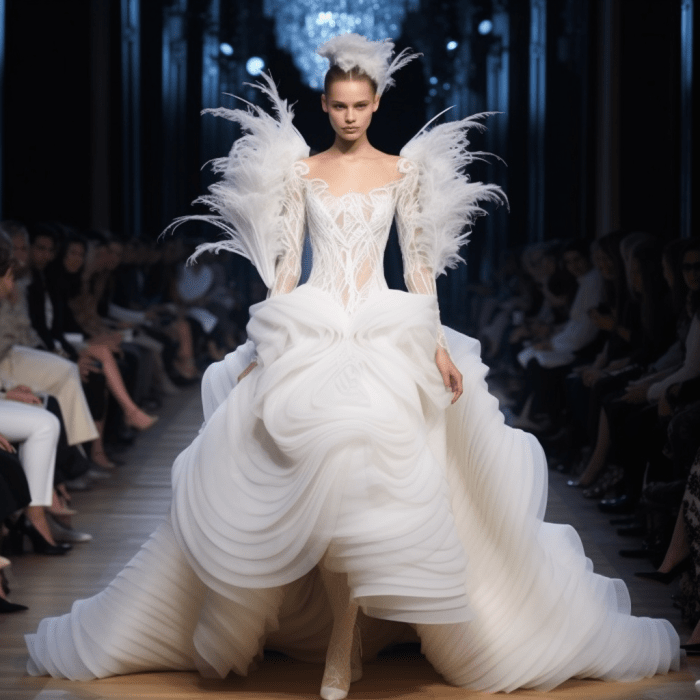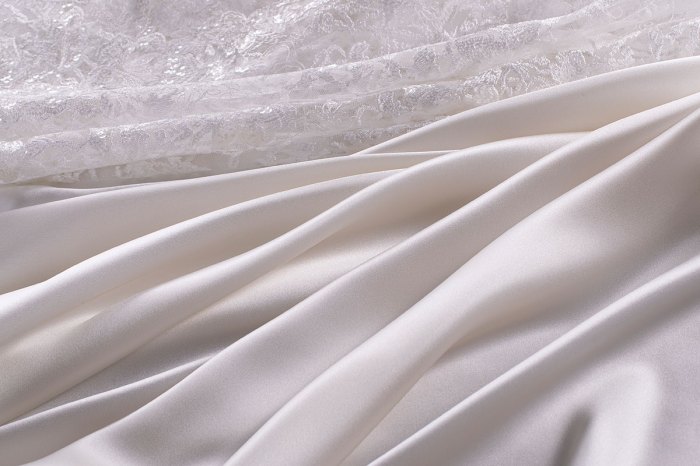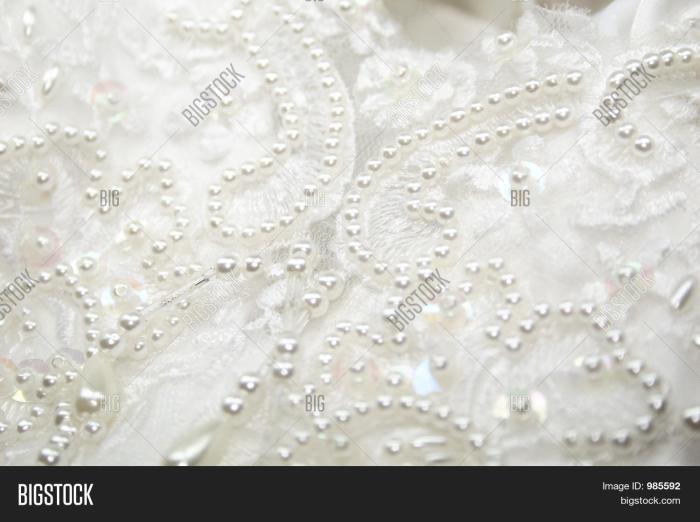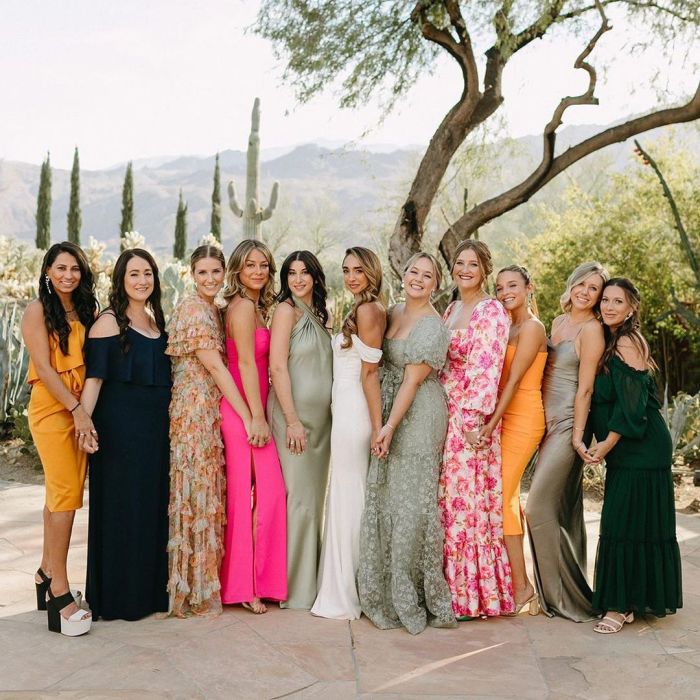Popular Wedding Dress Fabric Types
Fabric of wedding dresses – Choosing the right fabric for your wedding dress is crucial, as it significantly impacts the silhouette, comfort, and overall aesthetic of the gown. Different fabrics offer unique textures, drapes, and levels of durability, influencing the final look and feel of the dress. This section explores ten common wedding dress fabrics, highlighting their characteristics and suitability for various styles.
Common Wedding Dress Fabrics
| Fabric Name | Texture Description | Drape Characteristics | Common Uses/Styles |
|---|---|---|---|
| Silk | Luxurious, smooth, and lustrous | Flows beautifully, drapes elegantly | A-line gowns, sheath dresses, elegant ballgowns |
| Satin | Smooth, shiny, and sleek | Drapes well, creates a sleek silhouette | Mermaid gowns, sheath dresses, simple A-line dresses |
| Lace | Delicate, intricate, and often patterned | Can be stiff or flowy depending on the type | Romantic ballgowns, bohemian A-line dresses, fitted gowns with lace overlays |
| Tulle | Lightweight, sheer, and delicate | Flows and floats beautifully, creates volume | Ballgowns, layered skirts, romantic overlays |
| Chiffon | Lightweight, sheer, and slightly crinkled | Drapes softly, creates a flowing silhouette | Flowy A-line dresses, bohemian gowns, beach wedding dresses |
| Organza | Stiff, sheer, and crisp | Holds its shape well, creates structured silhouettes | Ballgowns, structured A-line dresses, princess-style gowns |
| Crepe | Slightly textured, matte, and drapes well | Creates a structured yet flowing silhouette | Sheath dresses, A-line gowns, tea-length dresses |
| Taffeta | Crisp, lustrous, and slightly stiff | Holds its shape well, creates a structured silhouette | Ballgowns, structured A-line dresses, princess-style gowns |
| Charmeuse | Smooth, luxurious, and has a subtle sheen | Drapes beautifully, creating elegant curves | Sheath dresses, mermaid gowns, A-line gowns |
| Mikado | Heavy, crisp, and has a slight sheen | Holds its shape exceptionally well, creates a structured silhouette | Structured ballgowns, sheath dresses, A-line gowns |
For example, a silk A-line gown will have a fluid, elegant drape, while a satin mermaid gown will showcase a sleek, form-fitting silhouette. Lace adds a romantic touch, often used for overlays or intricate detailing. Tulle creates volume and movement, particularly in ballgowns. The choice of fabric significantly influences the overall aesthetic and feel of the dress.
Choosing the right fabric for your wedding dress is crucial, impacting both its aesthetic and longevity. The delicate nature of many materials, such as silk or lace, necessitates careful cleaning, which is why finding a reputable service like those offered by a dry cleaner wedding dress specialist is essential. Proper cleaning helps preserve the fabric’s integrity and ensures your dress remains a cherished keepsake for years to come.
Silk is luxurious but can be expensive and requires careful cleaning. Satin is relatively easy to care for but can wrinkle easily. Lace is delicate and requires gentle handling. Tulle is durable but can be prone to snagging. Chiffon is lightweight and breathable but can be delicate.
Fabric and Wedding Dress Silhouette
The choice of fabric directly influences the silhouette of a wedding dress. Heavier fabrics create more structured shapes, while lighter fabrics allow for flowing, softer silhouettes. This section explores the relationship between fabric and silhouette for various dress styles.
Fabric and Silhouette Examples
An A-line dress, for instance, can be crafted from various fabrics. A lightweight chiffon will create a romantic, flowing A-line, while a heavier crepe will result in a more structured, defined shape. A ballgown typically utilizes fabrics like tulle or organza to achieve its voluminous skirt. A mermaid gown often features a heavier fabric like satin or Mikado to accentuate the body-hugging silhouette.
Sheath dresses are often made from fabrics like crepe or silk that drape smoothly. Empire waist gowns frequently use lightweight, flowing fabrics such as chiffon or silk to create a soft, ethereal look.
Wedding Dress Sketches
Imagine three sketches: Sketch 1: An A-line gown made from flowing chiffon, creating a soft, romantic silhouette. Sketch 2: A mermaid gown in structured Mikado, emphasizing curves and a defined shape. Sketch 3: A ballgown in layered tulle, achieving maximum volume and a princess-like aesthetic.
The drape and flow of fabrics directly impact the overall silhouette and movement of the dress. Lightweight fabrics like chiffon and tulle create soft, flowing movement, while heavier fabrics like satin and Mikado create a more structured, less flowing silhouette.
Fabric and Seasonality
The season of your wedding plays a significant role in fabric selection. Lightweight, breathable fabrics are ideal for warmer months, while warmer fabrics are suitable for colder months. This section explores fabric suitability for different seasons.
Fabric Suitability by Season
| Season | Suitable Fabrics | Reasoning | Aesthetic Impact |
|---|---|---|---|
| Spring | Silk, chiffon, lace, crepe, cotton | Lightweight, breathable, and comfortable in mild temperatures | Creates a fresh, airy, and romantic feel |
| Summer | Cotton, linen, silk organza, chiffon, batiste | Lightweight, breathable, and ideal for warm weather | Creates a light, airy, and comfortable feel |
| Autumn | Lace, crepe, velvet, satin, brocade | Offers warmth and texture suitable for cooler temperatures | Creates a rich, luxurious, and elegant feel |
| Winter | Velvet, brocade, silk, satin, heavy crepe | Provides warmth and richness suitable for cold weather | Creates a warm, luxurious, and opulent feel |
The choice of fabric can significantly influence the overall feeling and aesthetic of a wedding. Lightweight fabrics create a sense of lightness and airiness, while heavier fabrics evoke a feeling of richness and luxury.
Fabric Care and Maintenance
Proper care and maintenance are crucial for preserving the beauty and longevity of your wedding dress. Different fabrics require different cleaning and storage methods. This section Artikels care instructions for five common wedding dress fabrics.
Fabric Care Instructions, Fabric of wedding dresses

Source: sohago.com
- Silk: Dry clean only. Store in a breathable garment bag away from direct sunlight and moisture.
- Satin: Dry clean preferred, but hand washing is possible with gentle detergent. Store in a breathable garment bag.
- Lace: Dry clean only. Handle with care to avoid snagging. Store flat or on a padded hanger.
- Tulle: Dry clean or hand wash gently. Avoid harsh detergents. Store carefully to prevent snagging.
- Chiffon: Dry clean or hand wash gently. Avoid harsh detergents. Store carefully to prevent wrinkling.
Improper care, such as using harsh detergents or improper storage, can lead to discoloration, damage, and reduced longevity of the fabric.
Fabric Cost and Sustainability: Fabric Of Wedding Dresses

Source: newtess.com
The cost of wedding dress fabrics varies significantly based on material source, production methods, and quality. Sustainability and ethical sourcing are also important considerations when choosing a fabric.
Fabric Cost and Sustainability

Source: bigstockphoto.com
Silk, for example, tends to be more expensive than polyester due to its natural origin and production process. Organic cotton is a more sustainable option compared to conventionally grown cotton, minimizing environmental impact. Recycled fabrics offer an eco-friendly alternative, reducing textile waste. Choosing sustainably sourced fabrics supports ethical practices and reduces the environmental footprint of your wedding dress.
The environmental impact of fabric production varies greatly. Synthetic fabrics often require significant energy and water resources during production and contribute to pollution. Natural fabrics, while often more sustainable, can also have environmental impacts depending on farming practices. Considering the entire lifecycle of a fabric, from production to disposal, is crucial for making environmentally conscious choices.
Clarifying Questions
Can I wear a heavy fabric like brocade in the summer?
While possible, heavy fabrics like brocade can be uncomfortable in warm weather. Lighter fabrics are generally preferred for summer weddings.
How do I know what fabric will suit my body type?
Consult with a bridal stylist. They can advise on fabrics that flatter your figure and create the desired silhouette.
What’s the difference between satin and silk?
Satin is a weave, while silk is a fiber. Satin can be made from various fibers, including silk, polyester, or nylon. Silk is naturally luxurious and more expensive.
How much should I budget for wedding dress fabric?
Fabric cost varies greatly depending on the type and quality. Expect to pay more for luxurious fabrics like silk or lace.

